Importance of Planet Detection
Kepler Mission Science Objectives
Mission Overview
Kepler Mission Search Space
Hypotheses to Be Tested
Detectable Planet Size
Expected Results
Laboratory Measurements of Transits
Flight System Characteristics
Mission Characteristics
Schedule
Download two page color SUMMARY (pdf format)
(A condensed version of what is on this page.)
Importance of Planet Detection:
The
centuries-old quest for other worlds like our Earth has been
rejuvenated by the intense excitement and popular interest surrounding
the discovery of giant planets like Jupiter orbiting stars beyond our
Solar System. With the exception of the pulsar planets, all of the
extrasolar planets detected so far are gas giants (Marcy and Butler,
2000). The challenge now is to find terrestrial planets which are 30 to
600 times less massive than Jupiter.
The Kepler Mission is
specifically designed to survey the extended solar neighborhood to
detect and characterize hundreds of terrestrial and larger planets in
or near the habitable zone. The habitable zone (Kasting et al. 1993)
encompasses the distances from a star where liquid water can exist on
the planet's surface.
Results from this mission will allow us to place our Solar System within the continuum of planetary systems in the Galaxy.
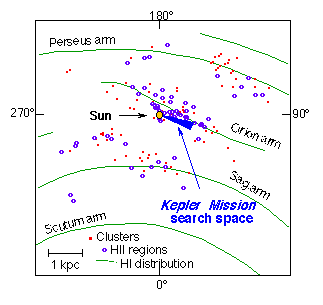
The Extended Solar Neighborhood
The
figure shows what we believe to be the local structure of our Galaxy,
the Milky Way. The stars sampled are similar to the immediate solar
neighborhood. Young stellar clusters, ionized hydrogen (HII) regions
and the neutral hydrogen (HI) distribution define the arms of the
Galaxy.
Kepler Mission Science Objectives:
The scientific goal of the Kepler Mission is to explore the structure and diversity of planetary systems. This is achieved by surveying a large sample of stars to:
- Determine
the frequency of terrestrial and larger planets in or near the
habitable zone of a wide variety of spectral types of stars;
- Determine the distributions of sizes and semi-major axes of these planets;
- Estimate the frequency and orbital distributions of planets in multiple-stellar systems;
- Determine the distributions of semi-major axis, albedo, size, mass and density of short-period giant planets;
- Identify additional members of each photometrically discovered planetary system using complementary techniques; and
- Determine the properties of those stars that harbor planetary systems.
The Kepler Mission also supports the objectives of the NASA Origins theme missions Space Interferometry Mission (SIM) and Terrestrial Planet Finder (TPF),
- By identifying the common stellar characteristics of host stars for future planet searches,
- By defining the volume of space needed for the search and
- By allowing SIM to target systems already known to have terrestrial planets.
Mission Overview:
Transits by terrestrial planets produce a fractional change in stellar brightness of 5 x 10-5 to 40 x 10-5 lasting for 2 to 16 hours. The orbit and size of the planets can be calculated from the period and depth of the transit.
The Kepler instrument is a 0.95-meter aperture differential photometer with a 105 deg2
field of view. It continuously and simultaneously monitors brightnesses
of 100,000 A-K dwarf (main-sequence) stars brighter than 14th magnitude. The experiment is not biased by preselection of stellar type or single versus multiple star system.
The
probability for the orbits to be properly aligned is about 1/2% near
the habitable zone (HZ). Detection of two transits suggest a candidate
planet with a third and all subsequent transits of a star with a
consistent period, amplitude and duration providing a rigorous method
of confirmation.
From measurements of the period, change
in brightness and known stellar type, the planetary size, orbital size
and characteristic temperature are determined. From this the question
of whether or not the planet is habitable (not necessarily inhabited)
can be answered.
The photometer must be spacebased to
obtain this precision and to avoid interruptions caused by day-night,
seasonal cycles and atmospheric perturbations, such as, extinction
associated with ground-based observing.
Kepler Mission Search Space:
The
Habitable Zone (HZ) is bounded by the range of distances from a star
for which liquid water can exist. Also the range of stellar types that
can have planets is limited to those stars for which there is enough
time for planets to form. The search space includes most of the HZ for
all stars less massive than spectral type A.
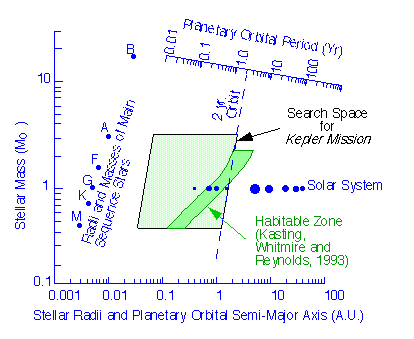
Range of Stellar Types and Orbits Searched
The Kepler Mission is designed to test the hypotheses that:
- Most main-sequence stars have terrestrial planets in or near the habitable zone;
- On an average two Earth-size planets form in the region between 0.5 and 1.5 AU, based on our Solar System and the accretion model of Wetherill (1996).
Detectable Planet Size
The minimum detectable planet size depends on the:
- Size of the star
- Brightness of the star, photometer aperture and optical efficiency (photon shot noise)
- Stellar variability (inherent noise of the source)
- Instrument differential precision (instrument noise)
- Number of transits (mission life divided by the orbital period)
- Detection efficiency (SNR and false alarm rate) and
- Duration of the transit (central or grazing)
The result of modeling all of this for the Kepler Mission is
shown below. Note that although the mission is optimized to detect
Earth-size planets in the habitable zone of solar-like stars, planets
even as small as Mercury are detectable.
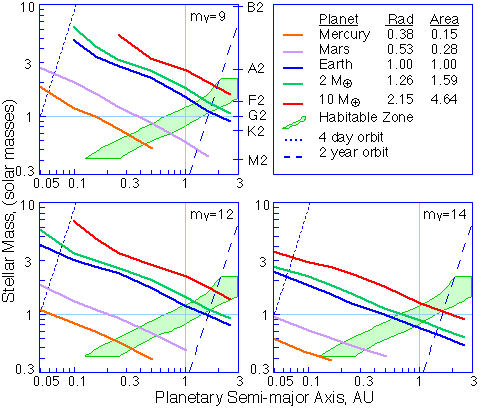
Detectable Planet Size
The
detectable planet size is shown for a near-central transit as a
function of the stellar mass and orbital size. Each plot is for a given
stellar brightness. Planets of a given size are detectable to the left
of each contour. Detections are based on a total SNR >8 sigma and >3 transits in 4 years. Masses for stellar spectral types B2-M2 are shown in the top left plot.
For example, at mv=12, a planet somewhat smaller than the Earth can be detected in a 1 AU orbit of a star of 1 solar mass.
Assumptions Used to Estimate Results
To estimate a detection rate, we define Earth-size planets to be those having masses between 0.5 and 2.0 Earth masses(Me) or equivalently, radii between 0.8 and 1.3 times that of Earth (Re) and large terrestrial planets to be between 2 and 10 Me (1.3 to 2.2 Re). Planets greater than 10 Me have enough gravity to attract a massive hydrogen-helium atmosphere. Those less than 0.5 Me
that reside in or near the HZ are likely to lose any life-supporting
atmosphere because of low gravity and the lack of plate tectonics
needed to recycle CO2 back into the atmosphere (Kasting, et al., 1993).
Given
the lack of empirical data on terrestrial planets in extrasolar
systems, the numbers, sizes and orbits of extrasolar-terrestrial
planets could be quite different from our Solar System. Nevertheless,
to quantitatively estimate the potential of the results for the Kepler Mission, we assume that:
- The white-light variability of most solar-like stars on the time scale of a transit is similar to that of the Sun.
- Continuous monitoring of 100,000 dwarf stars;
- Four years of observing; and
- The 1/2% transit probability per planet in or near the habitable zone.
Expected Results:
Based
on the assumptions described above, we expect to perform a census of
planets with periods from days to a few years and to detect:
Transits of terrestrial planets:
- About 50 planets if most have R~1.0 Re,
- About 185 planets if most have R~1.3 Re,
- About 640 planets if most have R~2.2 Re,
- About 12% with two or more planets per system.
Modulation of the reflected light from giant inner planets:
- About 870 planets with periods less than one week.
Transits of giant planets:
- About 135 inner-orbit planet detections along with albedos for about 100 of them,
- Densities for 35 inner-orbit planets, and
- About 30 outer-orbit planet detections.
Detection
of the short-period giant planets should occur within the first several
months of the mission, with a continuum of results throughout the
duration of the mission depending on the planetary orbital periods. The
results from this mission are meant to test the hypotheses and to
determine the characteristics of a wide variety of planetary systems.
The sample size of stars for this mission is large enough to capture
the richness of the unexpected. Should no detection be made, a null
result would still be very significant.
Laboratory Measurements of Transits:
Laboratory
tests were performed with a back-illuminated Marconi 42-80 CCD to
demonstrate that the total system noise with all confounding noise
factors expected for a space mission is < 2x10-5
with 6.5 hr integrations over intervals of weeks. The result
demonstrates that with currently available CCDs and appropriate
instrument and analysis software designs, the Kepler Mission has sufficient differential photometric precision to detect transits of Earth-size planets.
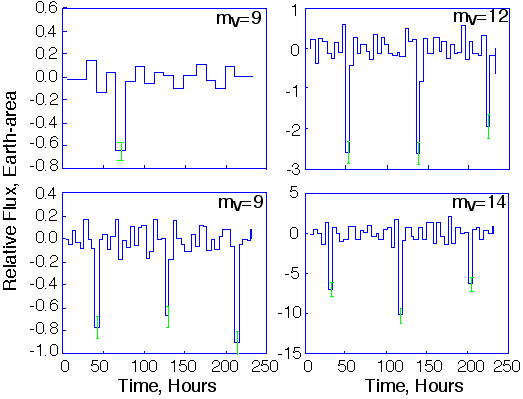
Sample Transits from the Lab Technology Demonstration
Earth-size transit signals of 12 and 5 hrs were measured for a stellar brightness range of mv
=9-14 in an end-to-end system test. Proto-flight software was used to
process the data. All vertical scales are linear in units of Earth-area
solar-analogs.
Flight System Characteristics:
Spacebased Photometer: ................................................................0.95-m aperture
Primary mirror:............................................................................85% light weighted
Detectors: ................................................................................42 - 2200x1024 CCDs
Photometric One-Sigma Noise Performance:
Total noise with solar-like stellar variability and photon
shot noise for an mv=12 star:...............................................<
2x10-5
No mechanisms besides antenna gimbals and one-time ejectable cover.
Spacecraft and instrument budgets:
Mass:......................................903 (including reserve) kg plus 34% margin
Power:....................................613 (including reserve) W plus 32% margin
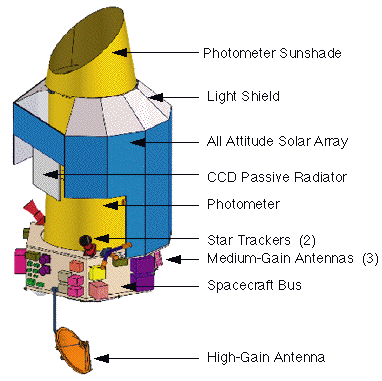
Kepler Photometer and Spacecraft
Mission Characteristics:
D2925-10L (Delta II) launch into an Earth-trailing heliocentric orbit.
Scientific Operations Center at NASA Ames.
Mission Operations Center at Honeywell
Data Management Center at Space Telescope Science Institute
Deep Space Network for telemetry.
Continuously point at a single star field in Cygnus.
Monitor 100,000 main-sequence stars for planets.
Mission lifetime of 4 years.
The Kepler Mission
is by far the best and quickest method for the detection and
characterization of a large number of Earth-size planets.The proposed
(not yet selected) Kepler Mission, a Discovery-class Mission, is designed to discover and characterize hundreds of terrestrial planets.
Schedule Based on a Dec. 2001 Selection:
Concept Study.........................3/01 to 7/01 (Proposal submitted July 20,2001)
Discovery down selection...................12/01 (Selection made Dec. 21, 2001)
Phase B ................................ 2/02 to 10/04
Phase C/D ..........................11/04 to 11/06
Launch ................................................10/07
Phase E .............................. 11/07 to 11/12 (flight operations ending 11/11)
Optional extended mission..........to 11/14 (flight operations ending 11/13)
Educational program .......... 10/02-11/11
|